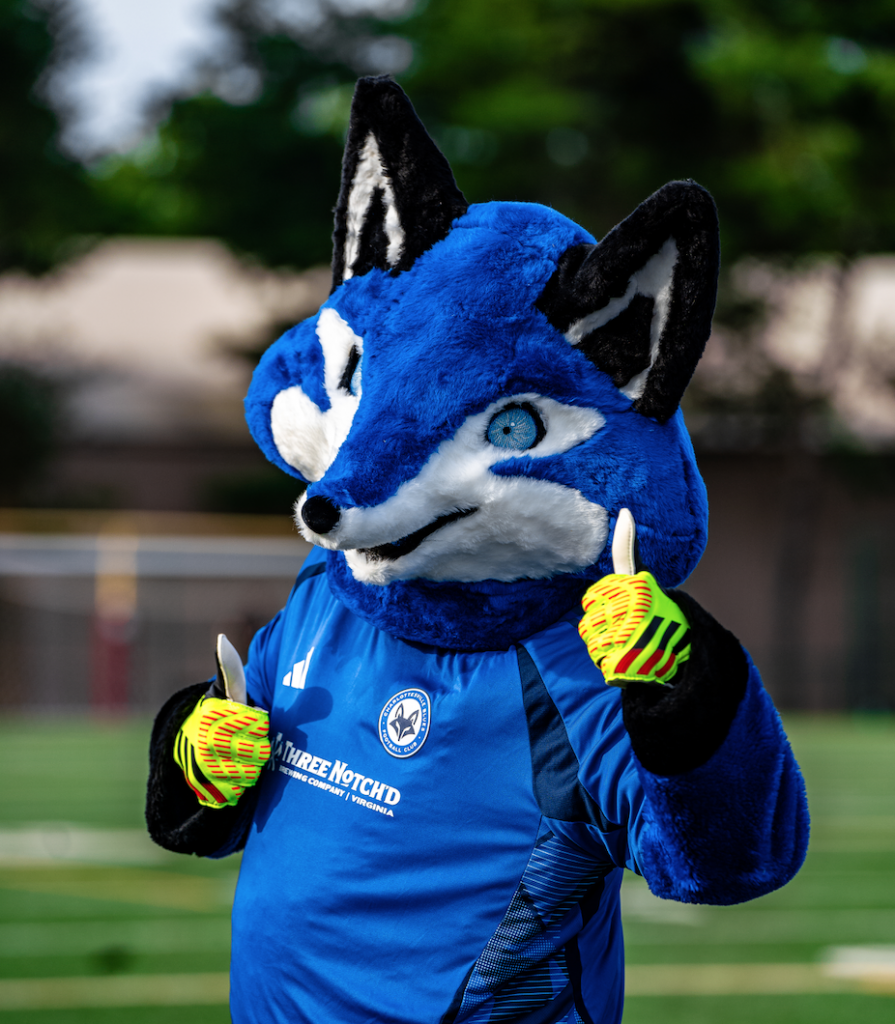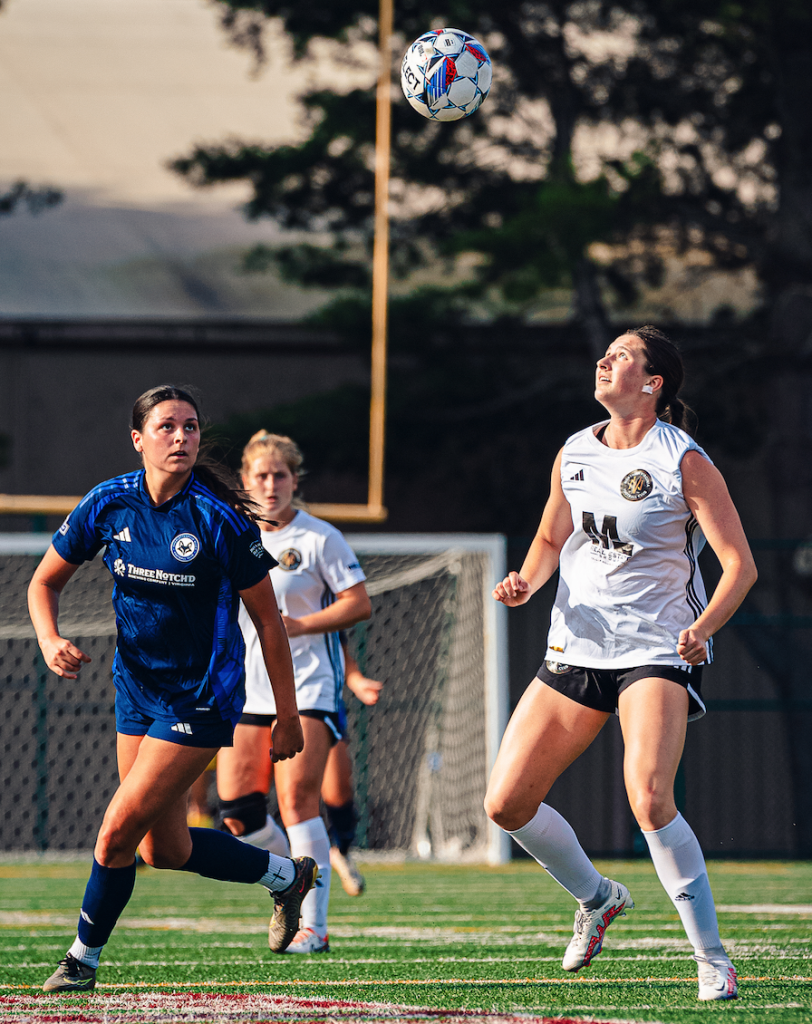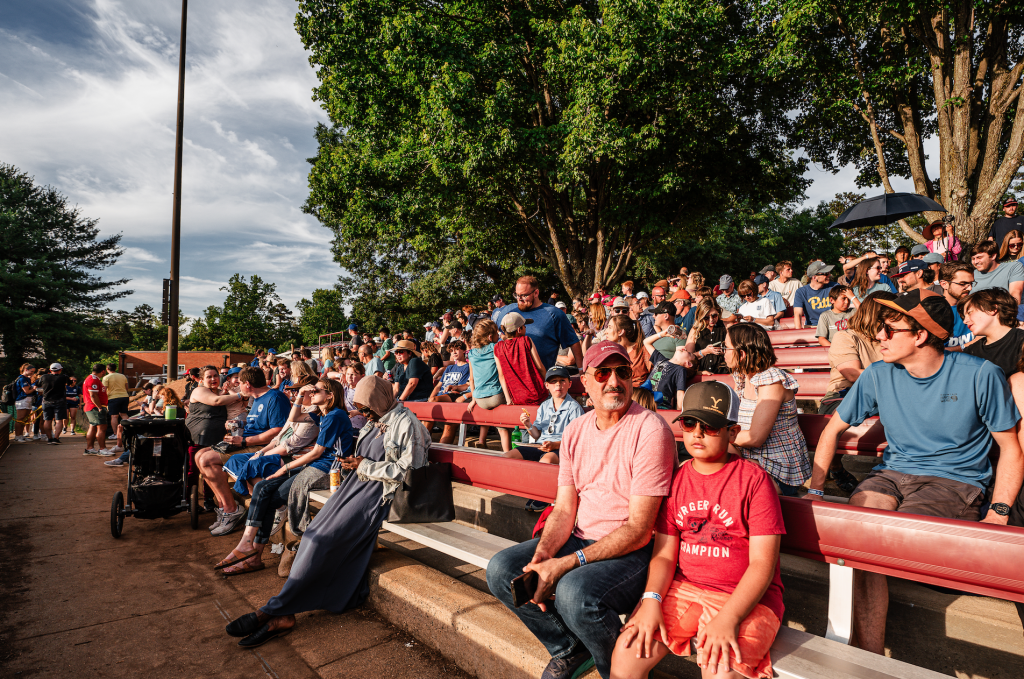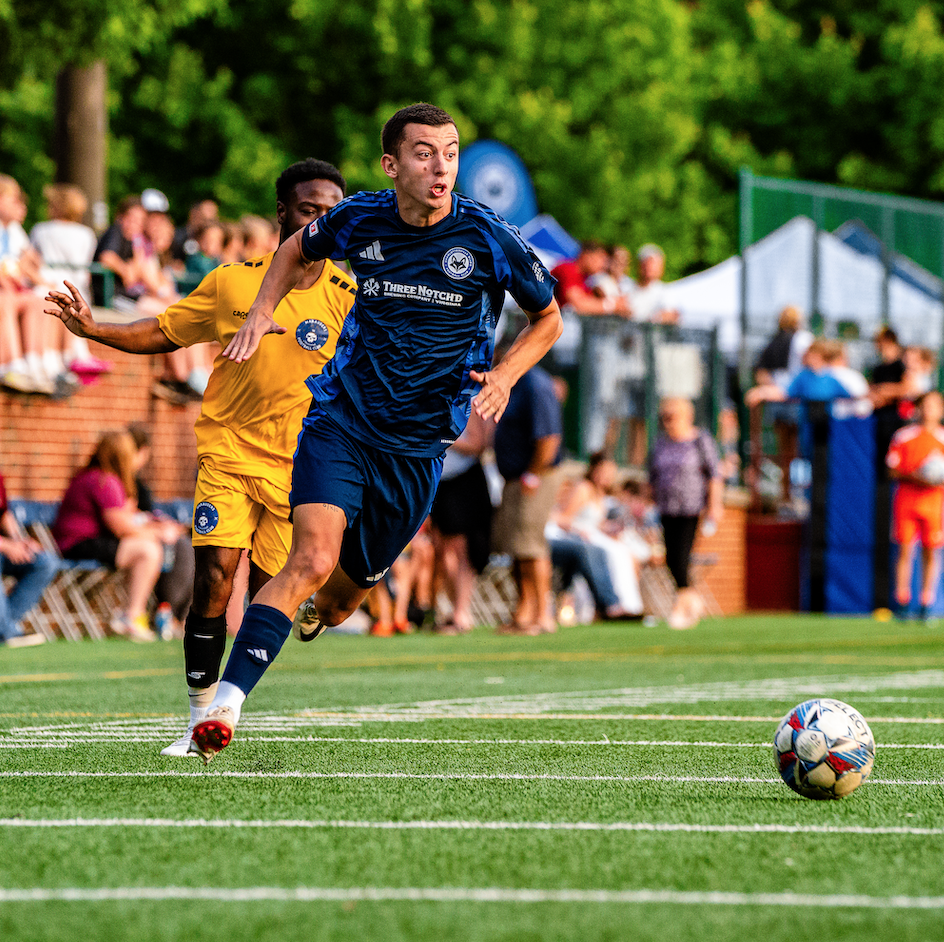Local soccer fans considering making the trip to New York or Los Angeles for the 2026 World Cup or 2028 Olympics needn’t go that far for a fix.
In fact, they’ll only have to travel as far as St. Anne’s-Belfield, where Charlottesville Blues FC is looking to seize on the growing popularity of American soccer by introducing United Soccer League-affiliated amateur men’s and women’s teams to Charlottesville.
“We will never see this level of injection into U.S. soccer history ever again,” co-owner Brian Krow says. “This is an unprecedented five years. That’s what really motivated us. Let’s get in, let’s start to build a fan base, build a community, build the sponsors, because our vision is to go full-time pro.”
The men’s club competes in the USL2, which expanded to a league-record 128 teams for the 2024 season, while the women’s team is taking on the 80-team USLW division.
The Blues’ inaugural season, which began in May and will conclude in July, pits the brand-new Charlottesville team, comprising college-age players and aspiring pros, against well-established pre-professional clubs with a history of sending players to the USL or international professional leagues.
The men’s team took on one of those pre-professional powerhouses on May 26 when they traveled to Newport News to face Lionsbridge FC, a club with 20 professional alumni that went to the USL League Two Championship game last season.

The Blues entered the game as consensus underdogs. Lionsbridge had not lost at home since 2019, marking 41 straight victories on their home field, and Charlottesville had yet to win a match.
But a goal from Princeton midfielder Samuel Vigilante and penalty kick from Mary Washington forward Josh Kirkland, combined with a strong Blues defense that limited Lionsbridge to two shots on goal, allowed Charlottesville to pull off a 2-0 shutout win.
“For us to secure this win at the start of our inaugural season truly sets the tone for what Charlottesville has to offer,” Krow says.
The Lionsbridge upset is the kind of result Krow was hoping for when he joined local co-owner Brian Kuk, as well as fellow co-owners John J. Kuk and Jim Kupec, in purchasing the rights to the teams in August, two years after beginning the process of bringing USL affiliates to Charlottesville.
The introduction involved consulting with other local clubs about how best to fit into the local sports landscape. The Charlottesville Tom Sox of the Valley Baseball League contributed advice about summer league business models and the logistics of hosting players with local families, while University of Virginia soccer provided local attendance analytics.
UVA soccer games are attended by an average of more than 1,800 fans on both the men’s and women’s sides, a statistic Krow says gave the Blues owners confidence the clubs could fill the 1,500-person stands at STAB.

“This is a family-friendly, community-based sporting event,” Krow says. “It’s going to be a different business model than probably most have seen, but it’s all about the matchday experience. It’s really about a community.”
The Blues logo—which features a Virginia Fox, the color of the Blue Ridge mountains, and a font inspired by the Paramount Theater—accordingly integrated the city.
“It’s all about tying in the community of Charlottesville on that one little crest,” Krow says.
The Blues also stayed local in their leadership search. The clubs hired two Virginia-based coaches in Carolyn Warhaftig, a teacher at Tandem Friends School whose previous coaching roles include an administrative operations role with the UVA women’s soccer team, and Tommy DiNuzzo, head coach of men’s soccer at Hampden-Sydney College since 2017.
Warhaftig and DiNuzzo were tasked with building rosters that both followed league rules, which only allow five players to join from each NCAA program, while featuring players with the drive to succeed in a program the USL describes as “pre-professional.”
“I have an understanding of the USL, and the level and soccer IQ of players playing at this level is tremendous,” Warhaftig says. “So, I knew we were not searching for just any player who wanted to play competitively. These are players who have aspirations to play in the National Women’s Soccer League, to play professionally in the States, or to play internationally at the pro level. It’s not your average player. It’s not just about your skill level and your athleticism anymore, but it’s about your tactical understanding and awareness and how well you can translate that onto the field.”

Luckily for the two coaches, the Blues were able to draw on the UVA soccer program to fill out their summer rosters with precisely that kind of player.
“Charlottesville is such a great location. UVA is absolutely the starting point, because they’re probably the most historic men’s college soccer program in the country,” DiNuzzo says. “I know there’s such a great soccer following, and great players come out of Charlottesville constantly, so we have a really strong base of local Charlottesville guys.”
That local pull means the Blues are offering Virginia soccer fans a first look at two UVA transfer defenders who led their respective teams in playing time last season. Luc Mikula, who is joining the Cavaliers following three seasons with Coastal Carolina, and Moira Kelley, an incoming transfer after four years with Kansas, will each be starting out their Charlottesville careers with the Blues.
Some of Mikula and Kelley’s summer teammates will also come from in-state schools, including William & Mary, Liberty University, University of Mary Washington, Longwood, Washington and Lee, University of Richmond, VCU, and Christopher Newport; others have traveled to Charlottesville from places as far as Japan, New Zealand, and Saint Lucia.
In return for the trip to Charlottesville, players get the chance to work under coaches with experience coaching at the college level, as well as the opportunity to play against high-quality competition.
An early-season men’s scrimmage pitted the Blues roster against a few DC United professionals, which is the kind of chance Charlottesville local and Longwood midfielder Joshua Yoder was hoping for when he signed up to play for DiNuzzo this summer.
“It’s just a good opportunity to see what’s at the next level, and not compare ourselves, but see the differences,” Yoder says.
Carolina Chao, a Charlottesville High School student and Blues defender, said playing for the Blues is the first time she has found a local opportunity to compete locally at a pre-professional level.
“To be honest, there’s not been a lot of soccer opportunities in Charlottesville that are the bridge between club and college,” Chao says. “There’s a lot of those opportunities in Richmond, and of course NOVA, D.C. … I’m super grateful that this has become a thing and I’m able to take advantage of the Charlottesville Blues because it’s so unique to have that right near me, only 15 minutes away.”
Blues players aren’t getting paid, so many are juggling the season between summer jobs in a bid to step up their games before the college season begins in the fall.
Some are also taking on the busy schedule because they want to be an inaugural member of the new club, DiNuzzo said.
“We have guys on the roster that are doing this to play at a great level, be a part of a first-year team, which I think is something special, and go and then really hit the ground running going into their college soccer season in the fall,” DiNuzzo said.
The Blues’ impact on these players could potentially last past college. After all, the USL designates these clubs as a potential pipeline into getting paid to play soccer.
Warhaftig, a former Colgate player who competed professionally in Iceland, wants her players to know a pro career is more possible than ever.
“Some of them may not have the belief in themselves yet that it really is a possibility,” Warhaftig says. “But my hope is that by surrounding themselves with players who are of that mentality, they will learn that they are very capable of playing professionally and gain knowledge that just because maybe they’re not going to play professionally in the U.S., doesn’t mean that there’s not a place for them to play abroad.”
Professional opportunities are now even greater for players on the women’s team thanks to the launch of the USL Super League, a professional women’s league kicking off their inaugural season in August.
“As a female soccer player, seeing this opportunity in Charlottesville has helped me,” Chao says. “And I think for the younger females playing the sport, it’ll be super helpful to see how there’s this opportunity, not just for soccer to go beyond college, but a different kind of thing that is available to them. It’s really been eye-opening to me about where the sport can go, especially on the female side.”
While players consider their own future careers, the Blues’ ownership is already looking at the next step in the rapid growth of the Charlottesville soccer landscape.
Krow said the team’s goal is ultimately to bring professional soccer to Charlottesville by launching a men’s USL League One club and women’s USL Super League team, which would hold games throughout the majority of the year rather than squeeze them in between college seasons.
Bringing these clubs to Charlottesville would require more than just renting out a high school field, however. League guidelines require that these teams play in stadiums capable of seating at least 5,000 fans, and even UVA’s Klöckner Stadium can only fit about 3,500 viewers in traditional seating.

Photo by Tristan Williams.
But that lack of a suitable venue might not be an issue in a few years. Krow says the Blues’ owners are already looking at purchasing land where a stadium of that size could potentially be constructed.
For now, the possibility of professional soccer matches taking place in Charlottesville will have to wait, at least until the Blues prove they can succeed as a pre-professional summer league.
But Krow already believes the next step is possible, in part because of local sponsors like Three Notch’d Brewing, which created a beer collaboration with the teams, and the Boar’s Head Resort, the brand displayed on players’ sleeves.
These companies started collaborating with the Blues even before the clubs’ season-openers kicked off, Krow said.
“The community support here is unbelievable, once you start to go around and meet everybody,” Krow says. “The amount of community sponsors that we have brought into the mix is crazy.”
Soccer fans can watch both Blues teams play in one of five doubleheaders taking place at St. Anne’s-Belfield. The teams’ full schedules, and live streams of every home game, can be found at charlottesvillebluesfc.com.
